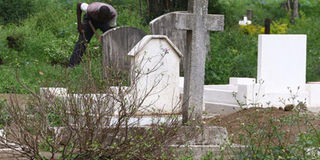Taboos, beliefs frustrating location of new Nakuru cemeteries

A worker at the Nakuru North Cemetery on June 14, 2015. PHOTO | SULEIMAN MBATIAH | NATION MEDIA GROUP
What you need to know:
- Njoro residents are the most affected as the Njoro cemetery was declared full more than five years ago while still under the management of the defunct Nakuru county council.
- The public health department issued a notice in June 2015 that all cemeteries that were filled up be closed and those that continued using it would be fined Sh1, 500 for each grave.
- A portion of the Nakuru South cemetery was allocated to private developers who built residential houses around the graveyard, leaving less land for its intended purpose.
Traditional beliefs and taboos among Nakuru residents have been cited as the major frustration in search of locations for three new cemeteries after current ones were declared full.
It has been over five years since the main cemeteries in Nakuru were declared full by county health officials, but getting new space has been a challenge.
The main cemeteries, which include the Nakuru North and Njoro cemeteries, cannot accommodate more bodies while little space is left in Nakuru South, and Gilgil cemeteries.
Njoro residents are the most affected as the Njoro cemetery was declared full more than five years ago while still under the management of the defunct Nakuru county council.
County Public Health officer Samuel King’ori has confirmed that three cemeteries were already filled up but no land has been found for new ones.
“We want to purchase parcels of land in Subukia, Naivasha and Nakuru where the cemeteries had already filled up,” he said in Nakuru.
SH1500 FINE
The county public health official is now proposing and encouraging Nakuru residents to embrace other ways of disposing the dead, including cremation, to address the issue of land shortage.
“If people embrace other ways of burying the dead we shall be able to address the issue of land problem,” he said.
The public health department issued a notice in June 2015 that all cemeteries that were filled up be closed and those that continued using it would be fined Sh1, 500 for each grave.
This has not stopped the residents as there is no alternative land for the purpose.
RESISTANCE
According to the county health official, it has been difficult for the county administration to secure new locations because of the resistance from locals.
He blamed it on stereotype beliefs among land owners and locals saying many of them are unwilling to sell their land for the purposes of putting up a cemetery
“We are having problems convincing some of the land owners to sell land to us. The moment they establish the purposes of acquiring such parcels, they chicken out,” said the County Public health boss who spoke at a workshop organised by the Nation Media Group at Waterbuck Hotel on Monday.
Nakuru county government has already set aside Sh80 million for the purchase of land according to the official.
Sh40 million was set aside in the current financial year and a similar amount will be set aside in the next budget.
Other challenges cited by the county health official include specifications required like topography and distance.
“We have managed to get a five acre land in Maai Mahiu in the outskirts of Naivasha town and we are carrying out due diligence,” said Mr King’ori.
The situation has been worsened by the fact that the county government has to burry unclaimed bodies every year.
Mr King’ori said Naivasha leads in the number of unclaimed bodies which were mostly buried in public cemeteries.
Nakuru North cemetery located along Hospital Road, now over nine decades old, was declared full in 2009.
A portion of the Nakuru South cemetery was allocated to private developers who built residential houses around the graveyard, leaving less land for its intended purpose.
In a desperate attempt to discourage residents from using the Nakuru North Cemetery, the defunct council hiked burial charges from Sh5, 000 to Sh10, 000 and now to Sh20, 000 per burial space.
The cemetery was set up in 1918 as the Commonwealth Graves Commission for casualties of the World War I.
It is estimated that about 220,000 people are buried at the North Cemetery and about 90,000 in the South Cemetery.






